|
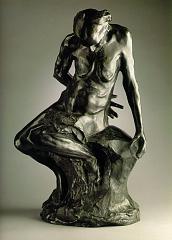
The sculpture 'Celle qui fut la belle heaulmière' is
also known as 'The old Woman', 'The old Courtesan' and 'Winter'.
In 1884-85,
Rodin modeled it after a 82 year old woman named Caira
, mother of an Italian model, because he was fascinated by the inevitable decline of human beings with
its different mouldings of ugliness and personality. Like for the model of
his 'Man with the Broken Nose',
Rodin found that what we call "...commonly [...] ugliness in nature
can in art become full of great beauty. [...] In art, only that which has
character is beautiful. Character is the essential truth of any natural
object."
 Since the character
is included in
'The Gates of Hell' on the lower left pilaster, Aida Audeh proposes to
consider the prostitute Thaïs, appearing in Canto XVIII of the 'Divine
Comedy', as the literary prototype of 'The Old Courtesan'. As a character from
Terence's 'Eunuchus', Thaïs is dwelling in the second Bolgia of
the Eighth Circle of the Inferno for the sin of falsely flattering
her lover - although Terence had actually attributed these empty words of
exaggeration to her servant Gnatho. Since the character
is included in
'The Gates of Hell' on the lower left pilaster, Aida Audeh proposes to
consider the prostitute Thaïs, appearing in Canto XVIII of the 'Divine
Comedy', as the literary prototype of 'The Old Courtesan'. As a character from
Terence's 'Eunuchus', Thaïs is dwelling in the second Bolgia of
the Eighth Circle of the Inferno for the sin of falsely flattering
her lover - although Terence had actually attributed these empty words of
exaggeration to her servant Gnatho.
Then said to me the Guide: "See that thou thrust
Thy visage somewhat farther in advance,
That with thine eyes thou well the face attain
Of that uncleanly and dishevelled drab,
Who there doth scratch herself with filthy nails,
And crouches now, and now on foot is standing.
Thais the harlot is it, who replied
Unto her paramour, when he said, 'Have I
Great gratitude from thee?'--'Nay, marvellous;'
Only after Rodin has exhibited his interpretation of Vanitas in the Salon
of 1890 under the title 'The old Woman', Paul
Gsell associated the sculpture in his 'Conversations with Rodin' with
the poem of François Villon - a monologue of the old
helmet-maker's wife about her expired beauty:
|
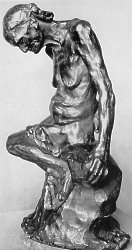 |
"Ha!
vieillesse felonne et fiere,
Pourquoy m'as si tost abatue?
Qui me tient que je ne me fiere,
Et qu'a ce coup je ne me tue? (...)
Quand
je pense, lasse! au bon temps,
Quelle fus, quelle devenue;
Quand me regarde toute nue,
Et je me voy si tres-changee,
Pauvre, seiche, maigre, menue,
Je suis presque toute enragee.
"Qu'est
devenu ce front poly,
Ces cheveulx blonds, (....)
"Ces gentes espaules menues, (....)
Petitz tetins, hanches charnues,
Eslevees, propres, faictisses
A tenir amoureuses lysses; (....)
"C'est
d'humaine beaute l'yssues!
Les bras courts et les mains contraictes,
Les espaulles toutes bossues;
Mammelles, quoy! toutes retraictes;
Telles les hanches que les tettes. |
"Ah, wicked old age
Why have you struck me down so soon?
[You] have stiffened me
so that I cannot strike
And with that kill myself!
When I think, alas! of the good times,
What [I] was, what [I] have become,
When [I] look at myself completely
naked
And I see myself so changed.
Poor desiccated thin, shriveled,
I nearly go mad!
What has happened to
my smooth brow,
My blond hair... .
My slender shoulders,
Small breasts, firm tighs
High, clean, perfectly made
For love's pleasures; (.....)
This is the fate of human beauty!
Shrunken arms and clenched hands
[And] completely hunchbacked.
What breasts! All wizened
Like my hips... ." |
Paul Gsell already compared Rodin's 'Helmetmaker's wife'
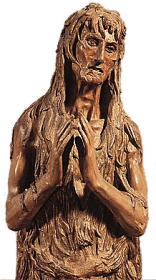 to Donatello's
'Magdalena' (1457), which Rodin probably had seen in Florence, in the Museo
Nazionale del Bargello.
There also exists an evident similarity to a sculpture of
an seated, old woman, called 'Helmet-Maker's Wife' of the artist Andrea Briosco known as
Riccio from Padua (1470-1532), exhibited in the Bibliotèque Nationale.
In his metal reliefs, Riccio had dealt with both subjects of
'Paradise' and 'Christ's Entombment' - motifs that were relevant for
Rodin's 'Gates', so that Rodin may have been familiar with Riccio's work. to Donatello's
'Magdalena' (1457), which Rodin probably had seen in Florence, in the Museo
Nazionale del Bargello.
There also exists an evident similarity to a sculpture of
an seated, old woman, called 'Helmet-Maker's Wife' of the artist Andrea Briosco known as
Riccio from Padua (1470-1532), exhibited in the Bibliotèque Nationale.
In his metal reliefs, Riccio had dealt with both subjects of
'Paradise' and 'Christ's Entombment' - motifs that were relevant for
Rodin's 'Gates', so that Rodin may have been familiar with Riccio's work.
Gsell explains the significance of Rodin's sculpture:
"The skin hangs in flacid folds upon the skeleton, the
ribs stand out beneath the parchment that covers them, and the whole
figure seems to totter, to tremble, to shrivel, to sink away.
Yet from this spectacle, at once grotesque and heart-rending, a great
sorrow breathes.
 For what we have before us is the infinite distress of a poor folish soul
which, enanoured of eternal youth and beauty, looks on helpless at the
ignominious disgrace of its fleshy envelope. It is the antithesis of the
spiriritual being which demands endless joy and of the body which wastes
away, decays, ends in nothingness. the substance perisches, the flesh
dies, but dreams and desires are immortal."
For what we have before us is the infinite distress of a poor folish soul
which, enanoured of eternal youth and beauty, looks on helpless at the
ignominious disgrace of its fleshy envelope. It is the antithesis of the
spiriritual being which demands endless joy and of the body which wastes
away, decays, ends in nothingness. the substance perisches, the flesh
dies, but dreams and desires are immortal."
It
has been noted that Rodin's assistants Jules Desbois and
Camille Claudel have created sculptures after the very same model as well.
Desbois created 'Poverty' (terra-cotta, Musée Rodin) and later 'Misery' (wood,
Musée des Beaux-Arts, Nancy)
and added a political dimension to his interpretation. It could not be
established with certainty if Desbois first modeled 'Poverty' and so
inspired his employer Rodin, or - as argued by Anne Pingeot - Desbois
rather conceived of 'Poverty' around 1887-89, whereas Rodin created his
'Old Courtisan' probably around 1884 - as can be concluded from an
anecdote related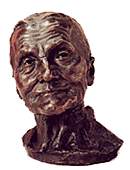 by Octave Mirbeau, according to which Rodin in that year
deplored he had ruined his clay model of the old woman. by Octave Mirbeau, according to which Rodin in that year
deplored he had ruined his clay model of the old woman.
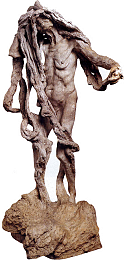 In 1893 Camille Claudel showed her symbolistic
description of 'Clotho'
spinning her hair to yarn.
This character also appeared in her group 'L' age mûr', dealing with the
fatal relationship between Rodin, Rose Beuret and herself and depicting
Rose in the role of Death. As early as 1882, however, one year before she
met Rodin in Boucher's sculpture class, Camille had sculpted
her terrra-cotta portrait of 'Old Helen', dealing with the wrinkled physiognomie of
an aged woman as well. In 1893 Camille Claudel showed her symbolistic
description of 'Clotho'
spinning her hair to yarn.
This character also appeared in her group 'L' age mûr', dealing with the
fatal relationship between Rodin, Rose Beuret and herself and depicting
Rose in the role of Death. As early as 1882, however, one year before she
met Rodin in Boucher's sculpture class, Camille had sculpted
her terrra-cotta portrait of 'Old Helen', dealing with the wrinkled physiognomie of
an aged woman as well.
In 'Triumphant Youth'
(also called 'Fate and the Convalescent'), exhibited at the 1896 Salon,
the character of 'The Helmetmaker's Wife' is shown with a young girl on her
lap. The nature of their relationship remains unclear.
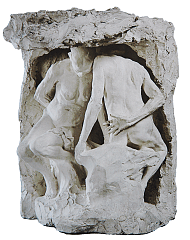 A double version of the old woman,
showing front and back in juxtaposition, can be found in the plaster relief
'Two old Women in a Grotto', displayed in 1889 at the Monet-Rodin
exhibition in Paris. This relief is also known under the name ''Dried-up Springs', probably referring to
a line of Villon's poem: "What breasts! All wizened,
Like my hips... ." In the Journal of the Goncourts of 3 July 1889,
these female figures are referred to as "women with dried-up breasts who
have lost all sex". A double version of the old woman,
showing front and back in juxtaposition, can be found in the plaster relief
'Two old Women in a Grotto', displayed in 1889 at the Monet-Rodin
exhibition in Paris. This relief is also known under the name ''Dried-up Springs', probably referring to
a line of Villon's poem: "What breasts! All wizened,
Like my hips... ." In the Journal of the Goncourts of 3 July 1889,
these female figures are referred to as "women with dried-up breasts who
have lost all sex".
|



 to Donatello's
'Magdalena' (1457), which Rodin probably had seen in Florence, in the Museo
Nazionale del Bargello.
There also exists an evident similarity to a sculpture of
an seated, old woman, called 'Helmet-Maker's Wife' of the artist Andrea Briosco known as
Riccio from Padua (1470-1532), exhibited in the Bibliotèque Nationale.
In his metal reliefs, Riccio had dealt with both subjects of
'Paradise' and 'Christ's Entombment' - motifs that were relevant for
Rodin's 'Gates', so that Rodin may have been familiar with Riccio's work.
to Donatello's
'Magdalena' (1457), which Rodin probably had seen in Florence, in the Museo
Nazionale del Bargello.
There also exists an evident similarity to a sculpture of
an seated, old woman, called 'Helmet-Maker's Wife' of the artist Andrea Briosco known as
Riccio from Padua (1470-1532), exhibited in the Bibliotèque Nationale.
In his metal reliefs, Riccio had dealt with both subjects of
'Paradise' and 'Christ's Entombment' - motifs that were relevant for
Rodin's 'Gates', so that Rodin may have been familiar with Riccio's work.
 For what we have before us is the infinite distress of a poor folish soul
which, enanoured of eternal youth and beauty, looks on helpless at the
ignominious disgrace of its fleshy envelope. It is the antithesis of the
spiriritual being which demands endless joy and of the body which wastes
away, decays, ends in nothingness. the substance perisches, the flesh
dies, but dreams and desires are immortal."
For what we have before us is the infinite distress of a poor folish soul
which, enanoured of eternal youth and beauty, looks on helpless at the
ignominious disgrace of its fleshy envelope. It is the antithesis of the
spiriritual being which demands endless joy and of the body which wastes
away, decays, ends in nothingness. the substance perisches, the flesh
dies, but dreams and desires are immortal." by Octave Mirbeau, according to which Rodin in that year
deplored he had ruined his clay model of the old woman.
by Octave Mirbeau, according to which Rodin in that year
deplored he had ruined his clay model of the old woman.
 In 1893 Camille Claudel showed her symbolistic
description of
In 1893 Camille Claudel showed her symbolistic
description of  A double version of the old woman,
showing front and back in juxtaposition, can be found in the plaster relief
'Two old Women in a Grotto', displayed in 1889 at the Monet-Rodin
exhibition in Paris. This relief is also known under the name ''Dried-up Springs', probably referring to
a line of Villon's poem: "What breasts! All wizened,
Like my hips... ." In the Journal of the Goncourts of 3 July 1889,
these female figures are referred to as "women with dried-up breasts who
have lost all sex".
A double version of the old woman,
showing front and back in juxtaposition, can be found in the plaster relief
'Two old Women in a Grotto', displayed in 1889 at the Monet-Rodin
exhibition in Paris. This relief is also known under the name ''Dried-up Springs', probably referring to
a line of Villon's poem: "What breasts! All wizened,
Like my hips... ." In the Journal of the Goncourts of 3 July 1889,
these female figures are referred to as "women with dried-up breasts who
have lost all sex".